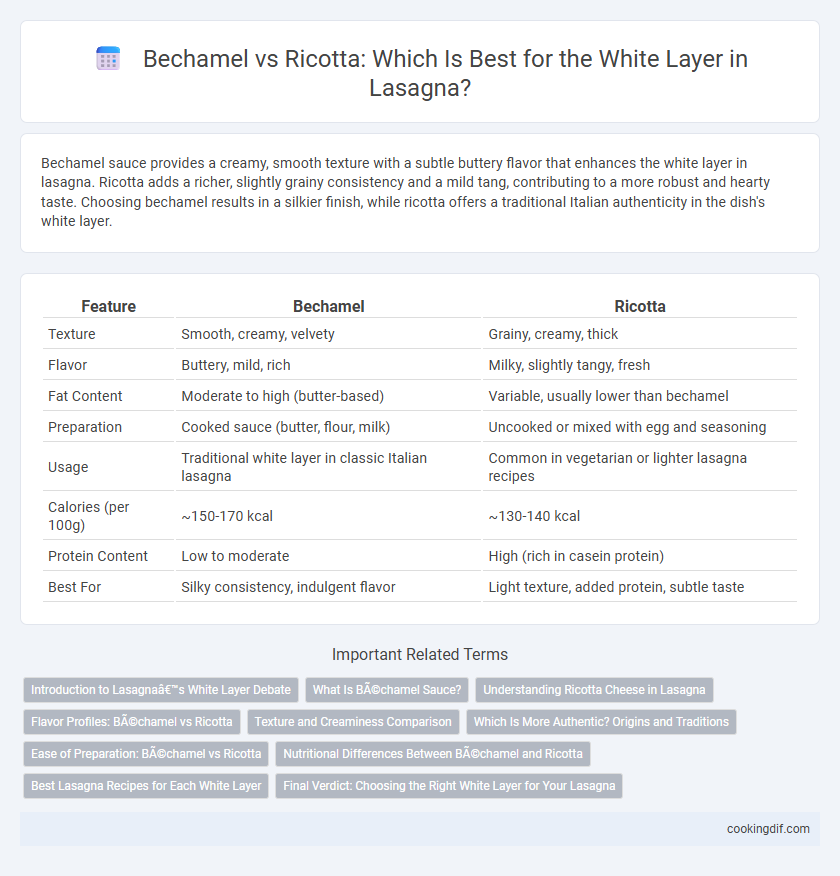Bechamel sauce provides a creamy, smooth texture with a subtle buttery flavor that enhances the white layer in lasagna. Ricotta adds a richer, slightly grainy consistency and a mild tang, contributing to a more robust and hearty taste. Choosing bechamel results in a silkier finish, while ricotta offers a traditional Italian authenticity in the dish's white layer.
Table of Comparison
| Feature | Bechamel | Ricotta |
|---|---|---|
| Texture | Smooth, creamy, velvety | Grainy, creamy, thick |
| Flavor | Buttery, mild, rich | Milky, slightly tangy, fresh |
| Fat Content | Moderate to high (butter-based) | Variable, usually lower than bechamel |
| Preparation | Cooked sauce (butter, flour, milk) | Uncooked or mixed with egg and seasoning |
| Usage | Traditional white layer in classic Italian lasagna | Common in vegetarian or lighter lasagna recipes |
| Calories (per 100g) | ~150-170 kcal | ~130-140 kcal |
| Protein Content | Low to moderate | High (rich in casein protein) |
| Best For | Silky consistency, indulgent flavor | Light texture, added protein, subtle taste |
Introduction to Lasagna’s White Layer Debate
The white layer in lasagna traditionally features either bechamel sauce or ricotta cheese, each offering distinct textures and flavors. Bechamel brings a creamy, smooth consistency with a subtle buttery taste, while ricotta provides a more textured, slightly grainy mouthfeel with a mild, tangy flavor. This debate influences lasagna's regional variations and personal preferences, shaping the dish's overall richness and authenticity.
What Is Béchamel Sauce?
Bechamel sauce, a classic French white sauce made from butter, flour, and milk, creates a creamy and smooth texture that enhances the layers of lasagna. Unlike ricotta, which is a grainy, cheese-based component, bechamel adds a velvety richness without overpowering other flavors. Its subtle taste and silky consistency make bechamel ideal for binding ingredients and providing moisture in traditional lasagna recipes.
Understanding Ricotta Cheese in Lasagna
Ricotta cheese, with its creamy texture and mild flavor, offers a lighter, slightly tangy alternative to bechamel sauce in lasagna's white layer. Unlike bechamel, which relies on butter, flour, and milk to create a thick sauce, ricotta provides a rich protein source and retains moisture, enhancing the dish's overall mouthfeel. Using ricotta in lasagna ensures a distinct, creamy consistency that balances tomato-based sauces and complements layers of pasta and meat.
Flavor Profiles: Béchamel vs Ricotta
Bechamel sauce offers a creamy, velvety texture with a subtle, buttery flavor that enhances the richness of lasagna without overpowering other ingredients. Ricotta cheese provides a slightly grainy texture and a mild, tangy taste that adds a fresh, light contrast to the savory layers. The choice between bechamel and ricotta influences the overall complexity and mouthfeel, with bechamel delivering smoothness and ricotta introducing a delicate, dairy tang.
Texture and Creaminess Comparison
Bechamel sauce provides a smooth, velvety texture that melts seamlessly into the lasagna layers, enhancing creaminess without overpowering other flavors. Ricotta offers a richer, slightly grainy consistency that adds body and a mild tang, creating a more rustic, hearty mouthfeel. Choosing bechamel results in a silkier, more cohesive white layer, while ricotta contributes a thicker, textured creaminess that holds shape better during baking.
Which Is More Authentic? Origins and Traditions
Traditional Italian lasagna recipes often use bechamel sauce for the white layer, especially in regions like Emilia-Romagna, where the classic Lasagna alla Bolognese originates. Ricotta cheese is more commonly found in Southern Italian versions, such as in Neapolitan lasagna, reflecting regional dairy production and culinary traditions. Authenticity depends on geographical context, with bechamel representing Northern Italian heritage and ricotta signifying Southern Italian influences.
Ease of Preparation: Béchamel vs Ricotta
Bechamel sauce requires careful temperature control and continuous stirring to avoid lumps, making it slightly more time-consuming and technique-sensitive. In contrast, ricotta offers ease of preparation with no cooking involved, simply requiring mixing with seasonings before layering. For home cooks seeking a quicker and less labor-intensive white layer, ricotta proves more convenient than bechamel in traditional lasagna recipes.
Nutritional Differences Between Béchamel and Ricotta
Bechamel sauce typically contains higher fat and calorie content due to butter and whole milk, offering a rich, creamy texture with moderate protein levels. Ricotta, on the other hand, is lower in fat and calories but higher in protein and calcium, making it a lighter and more nutrient-dense option. Choosing between bechamel and ricotta affects the lasagna's overall nutritional profile, with ricotta contributing more dairy-based protein and bechamel adding more saturated fat and calories.
Best Lasagna Recipes for Each White Layer
Bechamel sauce offers a creamy, velvety texture with a rich butter and milk base, ideal for classic lasagna recipes like Lasagna alla Bolognese, enhancing depth and smoothness. Ricotta brings a lighter, slightly tangy flavor with its creamy yet fluffy consistency, perfect for vegetable or spinach lasagnas that benefit from a subtle dairy richness. Choosing between bechamel and ricotta depends on desired texture and flavor intensity, with bechamel yielding a silkier white layer and ricotta providing a more airy, fresh component.
Final Verdict: Choosing the Right White Layer for Your Lasagna
Bechamel sauce offers a creamy, velvety texture with a subtle nutmeg flavor, creating a rich and smooth white layer ideal for classic Italian lasagna. Ricotta cheese provides a thicker, slightly grainy consistency with a mild, tangy taste, adding sturdiness and a more rustic character to the dish. Choosing between bechamel and ricotta depends on whether you prefer a silky, traditional white sauce or a hearty, cheese-forward layer that balances the tomato and meat components.
béchamel vs ricotta for white layer Infographic

 cookingdif.com
cookingdif.com